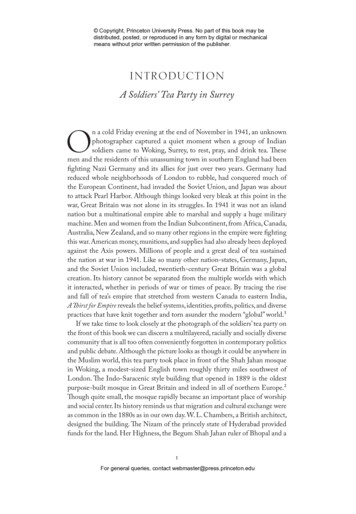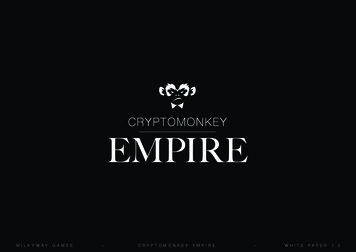
Transcription
Copyright, Princeton University Press. No part of this book may bedistributed, posted, or reproduced in any form by digital or mechanicalmeans without prior written permission of the publisher.INTRODUCTIONA Soldiers’ Tea Party in SurreyOn a cold Friday evening at the end of November in 1941, an unknownphotographer captured a quiet moment when a group of Indian soldiers came to Woking, Surrey, to rest, pray, and drink tea. Thesemen and the residents of this unassuming town in southern England had beenfighting Nazi Germany and its allies for just over two years. Germany had reduced whole neighborhoods of London to rubble, had conquered much ofthe E uropean Continent, had invaded the Soviet Union, and Japan was aboutto attack Pearl Harbor. Although things looked very bleak at this point in thewar, Great Britain was not alone in its struggles. In 1941 it was not an islandnation but a multinational empire able to marshal and supply a huge militarymachine. Men and women from the Indian Subcontinent, from Africa, Canada,Australia, New Zealand, and so many other regions in the empire were fightingthis war. American money, munitions, and supplies had also already been deployedagainst the Axis powers. Millions of people and a great deal of tea sustainedthe nation at war in 1941. Like so many other nation- states, Germany, Japan,and the Soviet Union included, twentieth- century Great Britain was a globalcreation. Its history cannot be separated from the multiple worlds with whichit interacted, whether in periods of war or times of peace. By tracing the riseand fall of tea’s empire that stretched from western Canada to eastern India,A Thirst for Empire reveals the belief systems, identities, profits, politics, and diversepractices that have knit together and torn asunder the modern “global” world.1If we take time to look closely at the photograph of the soldiers’ tea party onthe front of this book we can discern a multilayered, racially and socially diversecommunity that is all too often conveniently forgotten in contemporary politicsand public debate. Although the picture looks as though it could be anywhere inthe Muslim world, this tea party took place in front of the Shah Jahan mosquein Woking, a modest- sized English town roughly thirty miles southwest ofLondon. The Indo- Saracenic style building that opened in 1889 is the oldestpurpose- built mosque in Great Britain and indeed in all of northern Europe.2Though quite small, the mosque rapidly became an important place of worshipand social center. Its history reminds us that migration and cultural exchange wereas common in the 1880s as in our own day. W. L. Chambers, a British architect,designed the building. The Nizam of the princely state of Hyderabad providedfunds for the land. Her Highness, the Begum Shah Jahan ruler of Bhopal and a1For general queries, contact webmaster@press.princeton.eduRappaport 164691.indd 119/06/17 12:45 PM
Copyright, Princeton University Press. No part of this book may bedistributed, posted, or reproduced in any form by digital or mechanicalmeans without prior written permission of the publisher.2 Introductionnumber of Muslim donors financed the building. Dr. Gottlieb Wilhelm Leitner,a brilliant linguist born in a Jewish family in Budapest in 1840, inspired andoversaw the project. A naturalized British citizen who worked for the colonialstate, Leitner was proficient in nearly fifty languages, served as an interpreterduring the Crimean war, studied in Turkey, received a doctorate from FreiburgUniversity in Germany, and at the age of twenty- three became Professor inArabic and Muslim Law at King’s College, London. He then moved to BritishIndia to take up the position as principal of the new Government College inLahore in 1864 and contributed to several literary and educational projects inIndia and Britain before building the mosque. Without romanticizing this worldthat was also rife with racial, religious, and social tensions as well as intellectualdebate, we need to acknowledge this history.One way to begin is to take a second look at the photograph of the soldiers’tea party. While the mosque is a tangible reminder of Britain’s global past, sotoo were the YMCA volunteers who drove their mobile canteen to Surrey, thesoldiers they served, and the unseen businesses, planters, politicians, and workerswho manufactured tea and the markets for this imperial product. This book istheir story. The tea these soldiers were drinking was grown primarily in Indiaand Ceylon but also in British colonial Africa. Tea planters and their publicistsfirst encouraged the YMCA and other similar agencies to manufacture, stock,and drive hundreds of tea cars to serve those in need. Why did so many workso hard to serve tea to Indian soldiers in wartime Surrey? The simple answer,and one that so many Britons would easily reach, was that tea was energizing,soothing, and boosted morale. “Tea is supposed to be the favourite drink of theprivileged sex,” recalled Admiral Lord Mountevans, Regional Commissionerfor Civil Defence in London during the war, but then he mused: “believe me,men became tea- drinkers in all our services, especially Civil Defence. It gave uscourage and that matey feeling which gets the best effort out of us to help ourfellow humans.”3 The notion that good tea would comfort the weary and supportthe weak seems so natural to those of us who drink caffeinated beverages that itis almost impossible to consider a time when anyone would suggest otherwise.Yet such reminiscences, the photograph on the front of the book, and the soldiers’tea party in Surrey were instances of commercial propaganda that the colonialtea industry disseminated virtually everywhere the Allies were training, fighting,or working for the war effort.A nurse who had treated the wounded after Rommel had “punched” theEighth Army “hard on the nose” and taken Tobruk in Libya in 1942 recalledhow though the men could barely talk, the first thing they asked for was a cupof tea.4 An Egyptian State Broadcasting Studio radio program that featuredthe military hospital recognized that the ubiquitous presence of tea in publicFor general queries, contact webmaster@press.princeton.eduRappaport 164691.indd 219/06/17 12:45 PM
Copyright, Princeton University Press. No part of this book may bedistributed, posted, or reproduced in any form by digital or mechanicalmeans without prior written permission of the publisher.A Soldiers’ Tea Party in Surrey 3life was in fact commercial propaganda, but this did not make the tea any lessappreciated. Speaking about the care of the soldiers, the announcer remarked:“Many of the men are of course suffering from loss of blood and shock,” but theyno doubt would recover because “the Army Medical Authorities have found thathot sweet Tea has, in such cases, very great value as a stimulant and restorer.”The speaker went on to reflect, “This seems like a battlefield adaptation of theadvertising slogan ‘Tea Revives You.’ But it must, I was told be hot and it mustbe sweet.”5 The observation that the Army Medical Authorities were soundinga great deal like an advertising slogan was apropos. The slogan “Tea RevivesYou” had entered the popular lexicon because British and Dutch tea plantershad advertised tea in this way in key markets around the world for decades.And it did not abate in wartime. To give just a few examples, during the wartea’s public relations machine screened films on tea and “National Defence”and lectured on the “proper” way to brew up a good pot of tea at the Port SaidRotary Club, Cairo’s Police Schools, and countless other venues. It slappedposters on hoardings that declared: “There is Health in Good Tea.”6 An industryleader explained in March 1942 that although the Japanese occupation of theNetherlands East Indies had cut off supplies from Java and Sumatra, Tea wasfighting back. He was not referring to the tortuous experience of tea gardenlaborers from Assam who had been conscripted to build roads to defend Indiaand, it was hoped, recapture Burma from the Japanese.7 He was rather describingthe huge public relations effort that planters had mounted to raise awareness of“the magnificent part that Tea is playing in the War Effort all over the world.”8A Thirst for Empire traces the origins, significance, and foreseen and unexpectedconsequences of, as well as opposition to, this effort to create a world marketfor the British Empire’s tea.We must begin this history long before the twentieth century, for the ideasbehind such propaganda were nearly as old as tea itself. Although the plant’s originsare still somewhat unclear, archaeologists have recently discovered 2,100- year- oldtea in western China, proving that tea was ingested in some fashion before anytextual or previous archaeological evidence of its existence.9 Scholars will no doubtdelve into how the tea buried in an emperor’s tomb was used, but we know thatthe Chinese understood that tea had restorative properties centuries before theGerman scientist Friedlieb Runge discovered caffeine in 1819.10 Virtually allcultures that enjoyed an infusion of the plant that Western science has namedCamellia sinensis recognized that it fought off sleep, and many believed it couldcure headaches, constipation, and other more serious disorders.11 Such benefitsand the caffeine that creates a mild biological and psychological compulsion havepreserved tea’s hold on its users, but there are many other ways to consume thissubstance and people often live quite happily without caffeine. Addiction hasFor general queries, contact webmaster@press.princeton.eduRappaport 164691.indd 319/06/17 12:45 PM
Copyright, Princeton University Press. No part of this book may bedistributed, posted, or reproduced in any form by digital or mechanicalmeans without prior written permission of the publisher.4 Introductionplayed an important part of the history of drugs, drink, food, and capitalism, butit cannot explain individual or social differences, diverse modes of preparation,changing preferences, or brand loyalty.12 Economics plays a role to be sure, butall things being equal, consumers still make countless culturally, socially, andpolitically informed choices when they purchase, prepare, ingest, and think aboutfoods and drinks, even those that are addictive in nature. Chemistry, biology, andeconomics simply do not determine the social and commercial worlds that haveinserted tea and similar commodities into the daily life of millions of individualsand the political economies of so many nations.While there were always those who disliked its taste or who called tea apoison, a waste of money, and a dangerous foreign import, virtually every culturethat has been in contact with tea has described it as an agent of civilizationand a temperate pleasure. Such ideas first appeared in China more than athousand years ago, but in the seventeenth and eighteenth centuries, Europeanscholars, merchants, and missionaries translated and reframed Chinese ideasabout tea (and similar commodities) and made them a core part of Europeanculture.13 Incorporating a strand of early modern social thought that proposedthat consumption and foreign commerce were positive forces that producedcivility and social harmony, tea’s advocates contended that it balanced theeconomy and produced a healthy and temperate self- controlled consumer.14This notion that tea was a civilizing force was critical to its success and itsfailures. We often think of temperance as a reaction against mass marketers’push to urge us to buy more, overeat, and shop till we drop. This, however, isa very contemporary understanding of the relationship between restraint andconsumption.15 Temperance did not reject the material world. It developed amorality of consumption that demonized certain commodities and consumerbehaviors while promoting others. Thus, as we will see here, the nineteenth- century transnational temperance movement transformed the food and drinkindustry, contributed to the making of the modern diet, and legitimized consumerism as a positive social force.16Even in the midcentury United States, during a time when consumers werebeginning to prefer coffee, an American merchant professed:No other production of the soil has, in equal degree, stimulated theintercourse of the most distant portions of the globe; nor has any otherbeverage, with equally alloyed benefit, so commended itself to the palatesof the people of the more civilized nations, or become so much a sourceof comfort, and a means of temperance, healthfulness, and cheerfulness;whilst it may be doubted if any other is equally restorative and stimulativeof the intellectual faculties of man.17For general queries, contact webmaster@press.princeton.eduRappaport 164691.indd 419/06/17 12:45 PM
Copyright, Princeton University Press. No part of this book may bedistributed, posted, or reproduced in any form by digital or mechanicalmeans without prior written permission of the publisher.A Soldiers’ Tea Party in Surrey 5This merchant’s description of tea applied a core idea of nineteenth- centuryliberalism, the faith that commerce was a civilizing agent, to a single commodity.Such ideas were not the exclusive property of the West, however. For example, in1906 the Japanese- born curator of Oriental Art at the Boston Museum, OkakuraKakuzo, published The Book of Tea, a small but widely read English- languagehistory, which celebrated what the author called “the Cup of humanity.” “ThePhilosophy of Tea,” Kakuzo believed, was not mere aestheticism, but itexpresses conjointly with ethics and religion our whole point of view aboutman and nature. It is hygiene, for it enforces cleanliness; it is economics,for it shows comfort in simplicity rather than the complex and costly; itis moral geometry, inasmuch as it defines our sense of proportion to theuniverse. It represents the true spirit of Eastern democracy by making allits votaries aristocrats in taste.18The cosmopolitan Kakuzo traveled widely but settled in the United States andjoined the wealthy and artistic circle surrounding Mrs. Isabella Stewart Gardner.It was at her home at Fenway Court that Kakuzo first publicly read his historyof tea and encouraged the consumption of Japanese culture in wealthy America.In myriad histories such as Kakuzo’s tea serves as a diplomat bridging the gapbetween East and West, rich and poor.At almost the same time that Okakura Kakuzo was writing his history,Indian tea planters proposed that the true tea of democracy, health, and civilization was not from Japan or China but from the British Empire. For example,in October 1914 one of several publicists dedicated to promoting Indian tea,A. E. Duchesne, published “Tea and Temperance” in The Quiver. It is fitting thatDuchesne should publish in this non- sectarian evangelical journal started byJohn Cassell, a temperance reformer and tea and coffee merchant who created amajor publishing house.19 These social worlds ensured that tea would be identifiedwith Britishness and Britain’s civilizing mission. This piece repeated the adagethat “the temperance reformer’s most valuable ally” had sobered up the Britishnation. Tea, Duchesne wrote, had eliminated the “drunken nurses and bibulouscoachman” of Dickensian times, had eradicated the need for every businessmanto “clinch his bargain over a glass,” and expelled the belief that “drunkenness wasthe test and evidence of British manliness.”20 The hot beverage had in a positiveway feminized twentieth- century Britain by evoking “delightful associations ofhome . . . the innocence of childhood, the sacredness of the mother, the love ofthe wife, the fascination of the daintily feminine.” Free of “vulgarity,” “rowdyism,”and “obscenity,” this simple good was “a factor in civilization.” Tea drinking wasmoreover a democratic habit enjoyed equally by the “fashionable dame,” “theFor general queries, contact webmaster@press.princeton.eduRappaport 164691.indd 519/06/17 12:45 PM
Copyright, Princeton University Press. No part of this book may bedistributed, posted, or reproduced in any form by digital or mechanicalmeans without prior written permission of the publisher.6 Introductionbusinessman,” “the clerk and the typist,” the “factory hand, the toiling sempstressand washerwoman, the navvy, and the soldier.”21 This celebration of domesticatedBritishness especially took hold after the devastation of the war years, but tea’sadvocates had been selling elements of this story since the seventeenth century.In 1914, however, tea was much more than a national symbol. It was aprotagonist in a tale about commerce and Christianity, democracy, civility, andempire. On the surface, Duchesne’s and Okakura Kakuzo’s texts seem very similar, but while Kakuzo saw tea as an example of Eastern civilization, Duchesnecontended that “the energy and business capacity of our British planters inIndia,” not Chinese farmers, had transformed the “luxury of the rich” into the“everyday drink of the poor.”22 Duchesne thus argued that British imperialismenabled mass consumption and spread civilization. In truth, Chinese farmersand an international merchant community had cultivated the Chinese tea thatVictorians so appreciated, and it was not until very late in the nineteenth centurythat most Britons drank or even knew about their empire’s tea. In Duchesne’sinterpretation, tea justified imperialism. Critics of empire have made the samepoint and noted how instead of being a diplomat easing relationships betweenpeoples and nations, tea was a thief or pirate, appropriating Eastern treasuresfor the benefit of the West.The humanist and imperial interpretations of tea’s historical role differ intheir attitudes to the impact of global economic and cultural exchange, but theysimilarly employ tea as a device to relate a story about human nature and globalrelationships. The humanist has tended to rely on a comparative model in whichmany diverse people participate as consumers in a shared pleasure. This approachtypically has emphasized consumer rituals and experiences rather than labor andunequal profits. Those who created our global economy and wrote its history,for example, often celebrated consumerism as a universal human trait, yet usedcommodities to enforce inequalities and difference. By contrast, what we couldcall the imperialist model has tended to highlight those inequalities and theenvironmental and human costs of plantation- based colonial economies. Thoughacademic histories have fallen more often into this category, both models havebeen around a long time and have been used to illuminate global connectionsand comparisons and reveal the intersecting histories of culture, economics, andpolitics. I also employ tea as a device to write the history of globalization butdo so without assuming that this process is inevitable or natural or that it hasproduced greater equality or homogeneity.By lifting the lid on a pot of tea and really looking at its contents, studyingwhere it was grown and who bought, sold, and consumed this commodity, we canexplain why British women and Indian soldiers drank tea together in wartimeWoking. We can also see how the British Empire exerted power over land, labor,For general queries, contact webmaster@press.princeton.eduRappaport 164691.indd 619/06/17 12:45 PM
Copyright, Princeton University Press. No part of this book may bedistributed, posted, or reproduced in any form by digital or mechanicalmeans without prior written permission of the publisher.A Soldiers’ Tea Party in Surrey 7tastes, and the daily habits of millions of people living in so many parts of theglobe. Using both a wide angle and a focused lens, this book demonstrates howadvertising, retailing, and other forms of distribution created and were shapedby the history of the British Empire and the integration of the world economysince the seventeenth century. This commodity- centered approach to worldhistory highlights the fantasies, desires, and fears that motivated buyers’ andsellers’ attitudes and behaviors. While I have revisited many themes that willbe familiar to scholars of empire and commodities, those in the tea business,and aficionados, I have built this history of tea from the ground up.23 I haveexplored a wide variety of corporate, colonial, advertising, associational, andpersonal archives in several countries to uncover the experiences and attitudes ofthe people who labored to make, sell, brew, and drink tea. Tea’s massive a rchiveillustrates that there was nothing straightforward about its history, and at nopoint since the seventeenth century has this history been untouched by thehistory of capitalism.24Many of the firms or brand names that we still associate with tea, such asLipton’s, Brooke Bond, Twinings, and Tetley, and many we are less familiarwith today, such as the Assam Company, Billy Brand Tea, or Horniman’s,play a pivotal role in this history. Rather than assuming the corporation is thedriving force behind globalization, however, I argue that early modern tradingmonopolies, particularly the British East India Company, the merchant firmsof the nineteenth century, and multinationals of the twentieth have overlappinghistories, and all of these types of corporations participated in and benefited frombelonging to a web of interconnected transnational and local relationships.25All these businesses were part of political, religious, familial, and industry- basedcommunities that moved within but also well beyond the official boundaries ofthe British Empire.26This history starts in the seventeenth century, at the beginning of a long- termshift from a Chinese to European and then a British- dominated global trade.Chinese and other Asian and Near Eastern people had manufactured, traded, andconsumed tea long before Europeans encountered the beverage. Early modernEuropeans played a relatively minor part in the trade compared to that of othertropical commodities such as sugar, tobacco, coffee, and cocoa. Nevertheless, inthe seventeenth century, the Dutch, French, and Portuguese acquired a taste forthe rare luxury and introduced the British to the drink. Over time a small butinfluential group of aristocratic and cosmopolitan Britons began to view andpromote tea as a panacea capable of curing most mental, physical, and socialdisorders. The British East India Company entered the trade and its efforts,and those of smugglers, private merchants, shopkeepers, medical experts, andtemperance enthusiasts, enabled tea to became a regular feature of social lifeFor general queries, contact webmaster@press.princeton.eduRappaport 164691.indd 719/06/17 12:45 PM
Copyright, Princeton University Press. No part of this book may bedistributed, posted, or reproduced in any form by digital or mechanicalmeans without prior written permission of the publisher.8 Introductionand diets of people in England, Scotland, and Wales, parts of Ireland, NorthAmerica, and other areas of the British Empire and British World in the lateeighteenth and early nineteenth centuries.Tea was very useful to state revenue and the creation of a sober society, but inan era of mercantilism, the mass consumption of foreign things bred dependencyand weakness, or so theorists believed. As is well known, the British began toexchange Indian- grown opium for Chinese tea as a way to stop the drain ofsilver from the nation’s coffers. The Chinese addiction to opium and Britishaddiction to tea became so intertwined that in both places myths developedabout the similarities between the two substances. This anxious relationshipshaped the history of retailing, advertising, consumption, and colonial conquestin India and the nature of tea production throughout the nineteenth century.The opium trade was one solution to trade imbalances and fears of dependency.Another was the search for alternative sources of supply. Beginning in the lateeighteenth century, the British contemplated growing their own tea within theboundaries of the Raj. In the 1820s, during a war with Burma, and with thehelp of local elites seeking a new source of money and power, a British soldierof fortune found tea growing wild in Assam, just outside the borders of theempire. Growing “British” tea thus began with the violent appropriation of landand labor and a good deal of subterfuge in Assam and China. However, the newgeneration of planters who launched the tea industry in Assam encounteredenormous resistance and made many errors. It was not until the late 1870s thatthe industry was on a sure footing, but markets were not forthcoming. Peoplesimply preferred Chinese tea. Indian teas did not find a significant market inGreat Britain until the 1880s, nearly fifty years after the first plantations hadbeen laid out. Promoters of these new teas secured those markets by stokinganti- Chinese sentiment and claiming that Indian tea was modern, healthy,pure, patriotic, and, most important, “British,” thereby transforming a foreignthing into a familiar object. Pure food activists, retailers, and Indian tea growers asserted that Chinese teas were adulterated with dangerous chemicals andbore the residue of sweaty and dirty Chinese laborers. Such stories and theblending of India’s leaf with that of China accommodated palates to the newBritish teas. By the 1890s, Britons, the Irish, and Australians were primarilydrinking the empire’s produce. Yet British markets never seemed capaciousenough, and planters felt compelled to conquer vast new colonial and foreignmarkets. They formed powerful and long- lasting trade associations that lobbiedgovernments and raised taxes that paid for massive, and often repetitive, globaladvertising campaigns. Planters, their allies, and associations thus cultivatedmany of the technologies and ideologies we associate with the history ofmodern consumer society.For general queries, contact webmaster@press.princeton.eduRappaport 164691.indd 819/06/17 12:45 PM
Copyright, Princeton University Press. No part of this book may bedistributed, posted, or reproduced in any form by digital or mechanicalmeans without prior written permission of the publisher.A Soldiers’ Tea Party in Surrey 9We need to pay special attention to the role of the planter in global history.If we follow planters as they moved through time and across space we willsee how they shaped the political and cultural economies surrounding tea. Bycultural economy, I mean the attitudes, sets of behaviors, and rituals aroundthe growing, trading, and consuming of tea. Planters included the owners andmanagers of large- scale agricultural operations known as estates, gardens, orplantations, but the “Planter Raj” also included the investors and members ofagency houses and cognate industries who may or may not have lived in India,Ceylon, British East Africa, and Dutch- controlled Java and Sumatra but whoidentified with this business. There were never very many European plantersliving in the empire. In the 1850s and 1860s, planters were a tiny fraction of theten thousand non- official Europeans— merchants, traders, and missionaries— inBritish India.27 The vast majority came from Scotland, but the early plantingindustry was more multifarious than has been supposed and there were manymixed- race individuals and families who financed and grew tea. Some indigenousplanters owned tea plantations, but white Europeans and major corporationscontrolled the industry.28 Wives, sisters, mothers, and daughters also helpederect the colonial hierarchies that sustained the planter class. Women investedin the growing and trading industries, spread knowledge about and sold thecommodity, but with a few notable exceptions they typically did not manageplantation agriculture.29The Planter Raj invented many of the advertising and marketing techniques thatsimilar industries still use today. Decades before Coca- Cola refreshed the worldor McDonald’s served fast food to millions, tea growers combined propaganda,politics, and ideas derived from preexisting consumer and commercial culturesto create tea drinkers in places as diverse as Glasgow, Cincinnati, and Calcutta.Although they met with a great deal of resistance, planters were nevertheless ableto alter retail and consumer practices, design new drinking habits, and transformbodily experiences. Business and family connections, politics, and religion, aswell as gender, class, and racial ideologies, helped cement far- flung commercialand consuming communities, as did fiscal, land, and other state policies. Plantersrelied on the many new technologies that inspired globalization in the nineteenthcentury, including the railway, clipper and steamship, telegraph, chain provisionshop, cooperative society, tea shop, newspaper, magazine, and exhibition.30 Theyalso readily used radio, cinema, popular music, market research, public relations,and television in the twentieth century. Additionally, trade associations andjournals were critical to their social power and global reach and provided theskeleton upon which planters created a new kind of global political economy andconsumer culture. The Indian Tea Association (ITA), for example, founded inthe late nineteenth century, is one of several key protagonists in the second halfFor general queries, contact webmaster@press.princeton.eduRappaport 164691.indd 919/06/17 12:45 PM
Copyright, Princeton University Press. No part of this book may bedistributed, posted, or reproduced in any form by digital or mechanicalmeans without prior written permission of the publisher.10 Introductionof this book. This body and similar institutions in Africa, Ceylon, and elsewheresustained the class, gender, and racial hierarchies of colonial rule and yet alsoproduced mass markets for tea in Europe, North America, Africa, and South Asia.To put it simply, planters did not stay on the plantation. Starting as early asthe 1850s and 1860s, planters traveled around and beyond the British imperialworld, seeking di
Yet such reminiscences, the photograph on the front of the book, and the soldiers’ tea party in Surrey were instances of commercial propaganda that the colonial tea industry disseminated virtually everywhere the Allie










